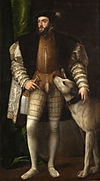Male undergarments
In the Middle Ages, western men's underwear became looser fitting. The loincloth was replaced by loose, trouser-like clothing called braies, which the wearer stepped into and then laced or tied around the waist and legs at about mid-calf. Wealthier men often wore chausses as well, which only covered the legs.
By the Renaissance, the chausses became form-fitting like modern Hose, and the braies became shorter to accommodate longer styles of chausses. However, chausses and many braies designs were not intended to be covered up by other clothing, so they are not actually underwear in the strictest sense.

Braies were usually fitted with a flap in the front that buttoned or tied closed. This codpiece allowed men to urinate without having to remove the braies completely. Henry VIII of England began padding his own codpiece, which caused a spiraling trend of larger and larger codpieces that only ended by the end of the 16th century. There are two possible explanations for Henry VIII's codpiece becoming larger and larger. It is speculated that he, along with many others in this time period, may have had the venereal disease syphilis. The large codpiece may have included a bandage soaked in medication to relieve the symptoms. It would then be wrapped again to protect the outer clothing. Henry VIII also wanted a healthy son and may have thought that projecting himself in this way would portray fertility.
The modern men's shirt appeared during this era, but it was originally an undergarment. Men would wear this long shirt under their other clothing and pull the long piece up from the back and then put their braies on over the shirt. In this way the shirt acted as underwear. Renaissance noblemen also adopted the doublet, a vest-like garment tied together in the front and worn under other clothing.
Source from : http://en.wikipedia.org/wiki







No comments:
Post a Comment